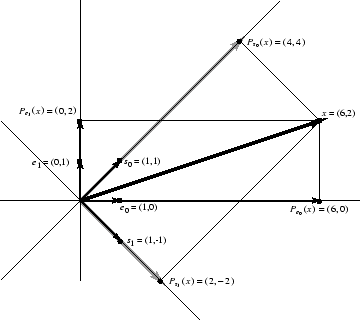NOTE: THIS DOCUMENT IS OBSOLETE, PLEASE CHECK THE NEW VERSION: "Mathematics of the Discrete Fourier Transform (DFT), with Audio Applications --- Second Edition", by Julius O. Smith III, W3K Publishing, 2007, ISBN 978-0-9745607-4-8. - Copyright © 2017-09-28 by Julius O. Smith III - Center for Computer Research in Music and Acoustics (CCRMA), Stanford University
<< Previous page TOC INDEX Next page >>
The Length 2 DFT
The length
DFT is particularly simple, since the basissinusoids are real:
The DFT sinusoidis a sampled constant signal, while
is a sampled sinusoid at half the sampling rate.
Figure 7.4 illustrates the graphical relationships for the length
DFT of the signal
.
Analytically, we compute the DFT to be
Note the lines of orthogonal projection illustrated in the figure. The ''time domain'' basis consists of the vectors, and theorthogonal projections onto them are simply the coordinate projections
and
. The ''frequency domain'' basis vectors are
, and they provide an orthogonal basis set which is rotated
degrees relative to the time-domain basis vectors. Projecting orthogonally onto them gives
and
, respectively. The original signal
can be expressed as the vector sum of its coordinate projections (a time-domain representation), or as the vector sum of its projections onto the DFT sinusoids (a frequency-domain representation). Computing the coefficients of projection is essentially ''taking the DFT'' and constructing
as the vector sum of its projections onto the DFT sinusoids amounts to ''taking the inverse DFT.''


